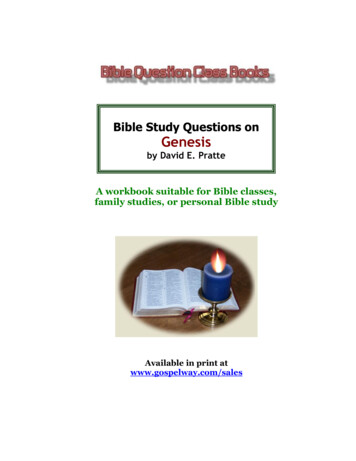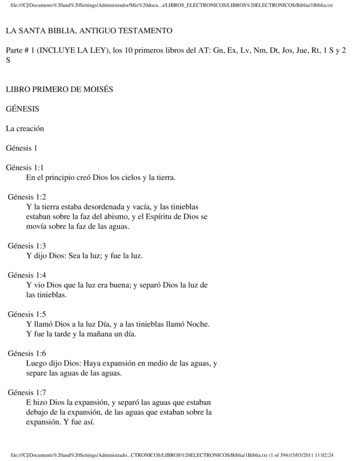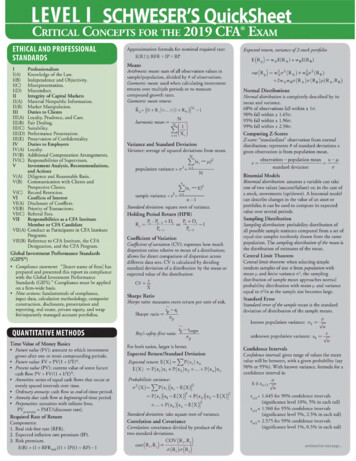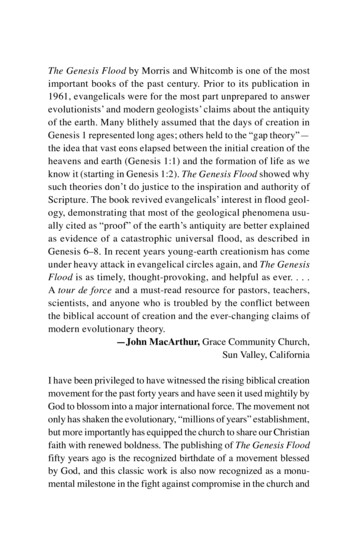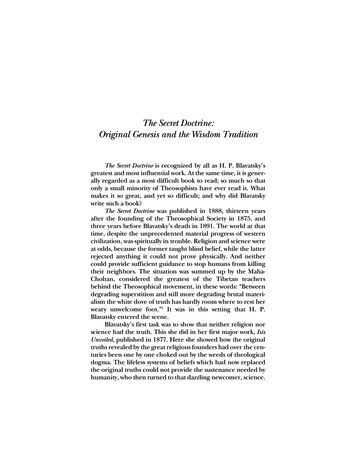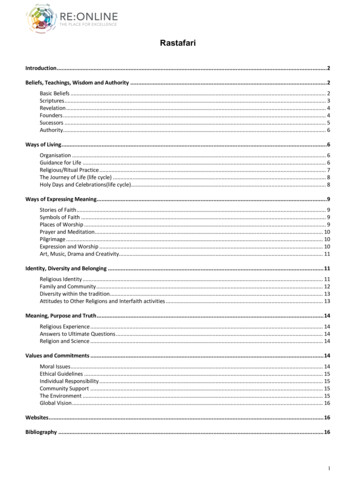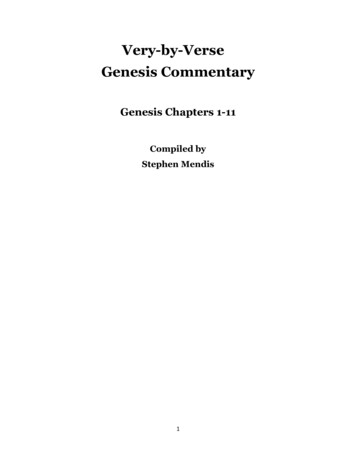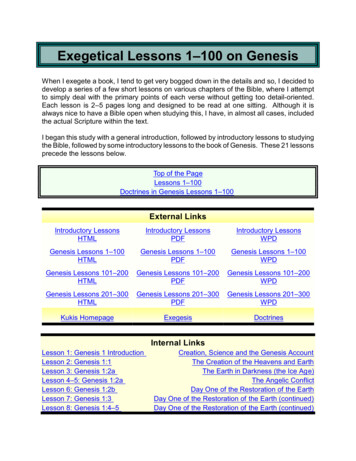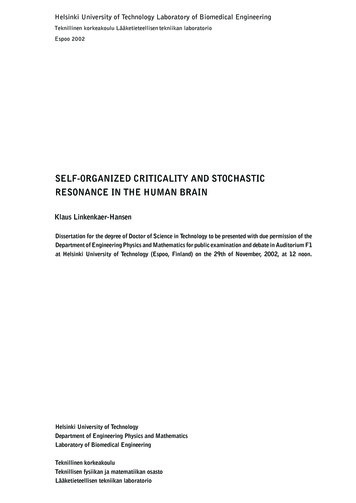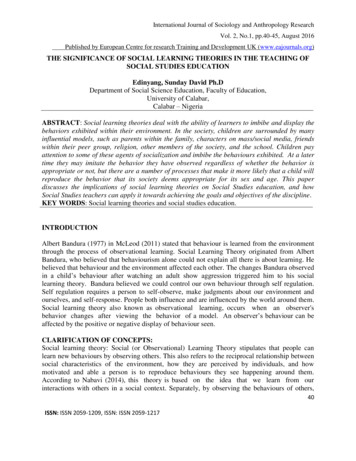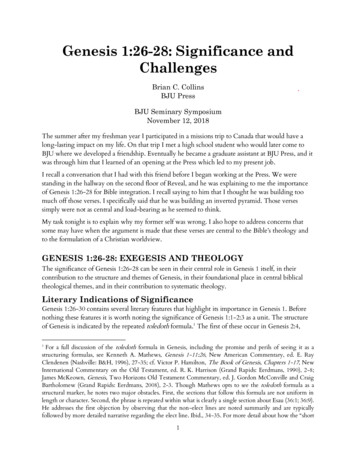
Transcription
Genesis 1:26-28: Significance andChallengesBrian C. CollinsBJU PressBJU Seminary SymposiumNovember 12, 2018The summer after my freshman year I participated in a missions trip to Canada that would have along-lasting impact on my life. On that trip I met a high school student who would later come toBJU where we developed a friendship. Eventually he became a graduate assistant at BJU Press, and itwas through him that I learned of an opening at the Press which led to my present job.I recall a conversation that I had with this friend before I began working at the Press. We werestanding in the hallway on the second floor of Reveal, and he was explaining to me the importanceof Genesis 1:26-28 for Bible integration. I recall saying to him that I thought he was building toomuch off those verses. I specifically said that he was building an inverted pyramid. Those versessimply were not as central and load-bearing as he seemed to think.My task tonight is to explain why my former self was wrong. I also hope to address concerns thatsome may have when the argument is made that these verses are central to the Bible’s theology andto the formulation of a Christian worldview.GENESIS 1:26-28: EXEGESIS AND THEOLOGYThe significance of Genesis 1:26-28 can be seen in their central role in Genesis 1 itself, in theircontribution to the structure and themes of Genesis, in their foundational place in central biblicaltheological themes, and in their contribution to systematic theology.Literary Indications of SignificanceGenesis 1:26-30 contains several literary features that highlight its importance in Genesis 1. Beforenothing these features it is worth noting the significance of Genesis 1:1-2:3 as a unit. The structureof Genesis is indicated by the repeated toledoth formula.1 The first of these occur in Genesis 2:4,1For a full discussion of the toledoth formula in Genesis, including the promise and perils of seeing it as astructuring formulas, see Kenneth A. Mathews, Genesis 1-11:26, New American Commentary, ed. E. RayClendenen (Nashville: B&H, 1996), 27-35; cf. Victor P. Hamilton, The Book of Genesis, Chapters 1-17, NewInternational Commentary on the Old Testament, ed. R. K. Harrison (Grand Rapids: Eerdmans, 1990), 2-8;James McKeown, Genesis, Two Horizons Old Testament Commentary, ed. J. Gordon McConville and CraigBartholomew (Grand Rapids: Eerdmans, 2008), 2-3. Though Mathews opts to see the toledoth formula as astructural marker, he notes two major obstacles. First, the sections that follow this formula are not uniform inlength or character. Second, the phrase is repeated within what is clearly a single section about Esau (36:1; 36:9).He addresses the first objection by observing that the non-elect lines are noted summarily and are typicallyfollowed by more detailed narrative regarding the elect line. Ibid., 34-35. For more detail about how the “short1
2making Genesis 1:1-2:3 the prologue to the book. As the prologue to the first book of the Bible,these verses also serve as the prologue to the entire Bible.2Within this prologue Genesis 1:26-30 stands out. Within the structure of the prologue, day six is theclimatic day of creation. Day six is the final day of creation activity, and the whole creation week hasbeen building to the final creation: man.3genealogies” and “extended narratives” relate to each other in the structure of Genesis, see Bruce K. Waltke andCathi J. Fredericks, Genesis: A Commentary (Grand Rapids: Zondervan, 2001), 18-19. Mathews does not presenta solution to the repetition of the toledoth formula in chapter 36, but a closer look at Genesis 36 reveals that therepetition in 36:9 serves a thematic function. Verses 1-6, reveal that Esau had lived in Canaan, married in Canaan,had sons in Canaan, and gained wealth in Canaan. Verses 6-7 recount Esau’s move away from Canaan becausethe land could not support both he and Jacob. Interestingly, Genesis 31-32 indicated that Esau was already livingin Seir. Perhaps Esau lived a nomadic lifestyle that took him back and froth between the two regions. Whateverthe harmonization of chapters 31-32 and chapter 36, 36:7 is clear that there is no more room for Esau in Canaanonce Jacob returned. The repeated toledoth formula in verse 9 adds the phrase “the father of the Edomites in thehill country of Seir.” It thus serves to reinforce the message that Esau does not inherit the promised land. Genesis36:9 is the only occurrence of the toldedoth formula that does not mark a division in the book.2Gordon J. Wenham, Genesis 1-15, Word Biblical Commentary, ed. David A. Hubbard (Nashville: Nelson,1987), 5; C. John Collins, Genesis 1-4: A Linguistic, Literary, and Theological Commentary (Phillipsburg, NJ:P&R, 2006), 39.3Peter J. Gentry and Stephen J. Wellum, Kingdom through Covenant: A Biblical Theological Understandingof the Covenants (Wheaton: Crossway, 2012), 182. Michael Morales argues that the Sabbath rest is “the telos orgoal of creation,” what he labels “humanity’s chief end.” Morales says that “without minimizing the significanceof the sixth day,” it is not the climatic day. It does not have the same structural emphasis that the seventh dayreceives, and arguments from “word allotment” are not sufficient to prove its importance. In addition, he arguesthat the creation mandate is subordinate to the Sabbath: “As the ‘crown’ of creation, humanity is made in the‘image’ (ṣelem) and ‘likeness’ (dĕmût) of God the Creator (Gen. 1:26-27). No doubt this status entitles man(hā'ādām), male and female, to rule and subdue the rest of creation, but the primary blessing of being created inGod's image is in order to have fellowship with the Creator in a way the other creatures cannot. The ‘rule andsubdue’ command, along with the ‘be fruitful, multiply and fill the earth’ blessing, should be directed to this chiefend and highest goal—hā'ādām is to gather all creation into the life-giving Presence and praise of God.” Moralesplaces a great deal of argumentative weight on the structure of Genesis 1:1-2:3. He notes that days 1-3 are abouthabitats, days 4-6 are about inhabitants, and the seventh day is “set apart.” This set-apartness is reinforced by thesummary statement in Genesis 2:1. Morales also proposes a second, complementary structure. Day 1 establishesday (day and night); days 2 and 3 establish places of “habitation.” Day 4 also deals with time, namely “annualcultic festivals” (not merely times and seasons). Days 5 and 6 pair with days 2 and 3 by being about inhabitants.Day 7 links up with days 1 and 4 by also being about time. Day 4 has a central location because it deals withcultic festivals and the word for lights is used of "the tabernacle lamp.” Morales takes this to indicate that whilehumans are to rule over the creatures of the earth, humans are subject to time, and to “day and night, culticfestivals,” in particular. Morales's point seems to be that the creation is headed toward the seventh day in itsemphasis on time and cultic festivals and with “day seven's consecration of the cultic day, the weekly Sabbath.”Morales concludes form this that the seventh day Sabbath (a time) is more significant than the creation mandate.Finally, he observes, “The seventh day is not only the first day to be blessed, and the only day mentioned threetimes, but it is also the first object ever to be set apart as holy by God. Moreover, the seventh day is the onlyobject of sanctification in the entire book of Genesis.” L. Michael Morales, Who Shall Ascend the Mountain ofthe Lord? A Biblical Theology of Leviticus, New Studies in Biblical Theology, ed. D. A. Carson (DownersGrove: InterVarsity, 2015), 43-47.
3With these verses, the narrative pace slows. More words are devoted to day six of the creation weekthan to any of the other days.4 Most of these “day six” words are in found in verses 26-30. Theincreased word count is not simply due to a greater amount of material to discuss. One reason for theadditional word count is increased repetition. In verse 26 God speaks of making man in his imageand of giving mankind dominion over the earth. Verse 27 then recounts that God made man in hisimage, and it does so using poetic repetition. Verses 28-29 then return to the theme of dominion,repeating and expanding upon verse 26. The increased repetition, and the first instance of poeticparallelism in the Old Testament, serve to highlight the importance of these verses.Morales is correct to highlight the importance of the seventh day, but key elements of his argument do not holdup under close examination. His identification of a palistrophe regarding days 1, 4, 7 hinges on the claim thatday 4 sets up the times for cultic festivals. But while מוֹ עֵד can refer to cultic festivals, it is a broad word that alsorefers beyond the cultic realm. In a creation Psalm (104:19), it is clearly contrasted with the normal order of dayand night and the seasons. I remain skeptical readings which seem to read cultic material back into Genesis 1 and2. It seems more plausible that Genesis 1 and 2 are about the establishment of the normal creation. Connectionsbetween creation and cult are due to the cult looking back to what was lost creationally and looking forward tothe creation’s restoration. The claim that human rule over creation is subordinate to the rule of the sun and moonover the day and the night also fails to convince upon closer examination. Morales’s reading would place partsof the creation over man, the image bearer of God. This becomes most problematic when Christ ultimatelyfulfills the rule of the Man who rules over creation (Heb. 2:6-9) because it would place Christ’s rule under therule of the sun and moon. In addition, different terminology is used of the rule of the celestial bodies and therule of man, suggesting that different kinds of rule are in view (the terms used of man indicate that he is tocontinue to shape the world that God has made; they are not static terms). Morales’s argument that “wordallotment” is not sufficient to demonstrate the significance of the sixth day is true in the abstract, but the argumentis not merely that there are more words given to day six. The argument is that the narrative pace shifts in orderto place special emphasis on the speech of God related to the creation of man. In addition, as will be arguedbelow verse 28 is the seedbed for the blessing, seed, land themes that are at the heart of all the covenants and theseedbed for the kingdom of God theme, which is central to the Bible's storyline and to the gospel. In otherwords, the increased “word allotment” is needed to lay the foundation for central biblical themes. Finally, Moralesis incorrect to say that the primary blessing of the imago dei is to have fellowship with God. Without minimizingthe importance of fellowship with God, this is not what the text says. Grammatically, the blessing of the imagodei is tied to the blessing of dominion over the earth. Likewise, with Morales’s claim that the seventh day is aboutthe presence of God/fellowship with God. These ideas are not found in Genesis 2:1-3. Humans are notmentioned in those verses, nor is the theme of presence/fellowship.Even so, Morales is correct to emphasize the importance of the seventh day. What is needed is a way to bringtogether Genesis 1:26-29 with the seventh day. Perhaps God is setting a telos for man in the seventh day. Godblessed mankind with rule over the earth, which meant that he was to extend the Garden to cover the world, asit were. At a certain point man would complete this work and enter into God's rest. I further wonder if underthe Second Adam this task will be completed in the Millennium after which man can enter the rest of the newearth. Humans will continue to reign under Christ on the new earth, but it will not be a reign of subduing andgaining dominion.Morales is also correct to argue that the presence of God is one of the central themes of Scripture. Exodus 33 isclear that to receive the seed and land blessings apart from God's presence is no blessing at all. But it seems thatthe presence of God theme is assumed rather than explicit in Genesis 1 and 2.4Mathews, Genesis 1-11, 159; Wenham, Genesis 1-15, 25; Gentry and Wellum, 182-83.
4These verses also differ from the pattern established by the other creation days.5 Instead of simplydeclaring, “Let there be . . . ,” there is instead a statement of divine intent: “Let us make man.”6 Thisdeliberative statement serves to heighten the importance of this section. Not only does the creationof man begin with a distinctive statement, in the closing formula, “And there was evening and therewas morning, the sixth day,” “the sixth day” is articular in Hebrew. The enumeration of days in thecorresponding formulas that precede day six is not articular. The article may signal that day six isspecial.7 In addition, it is at the end of this day that God pronounced all he made to be “very good,”an intensification of the earlier forms of this formula.8Finally, the content of these verses highlights their importance. Man is singled out as bearing God’simage.9 A specific, stated blessing is bestowed on mankind. The relation between the human andnon-human creation is specified.Contextual Indications of SignificanceGenesis 2:4-4:26 is the first major section of Genesis. The importance of Genesis 1:26-30 can be seenin the way themes from these verses are utilized in this section of the book. William Dumbrell makesthe suggestive comment, “The remainder of Genesis 2 [that is, vv. 4-25] seems primarily anexposition of chapter 1:26-28 in which the creation of man as a species has been discussed and wherethe dominion given to man is thus conferred upon mankind.”10 While Genesis 3 and 4 may not bean exposition of Genesis 1:26-28, these verses do figure significantly in those chapters.Genesis 2:5-25Genesis 2:5-9 exposit the dominion aspects of Genesis 1:26-28. This is clouded somewhat bynumerous translation difficulties in these verses, but it can be seen in clearly in the Holman ChristianStandard Bible:No shrub of the field had yet grown on the land, and no plant of the field had yet sprouted, for theLord God had not made it rain on the land, and there was no man to work the ground. But waterwould come out of the ground and water the entire surface of the land. Then the Lord God formed5Wenham also notes features that are true only of days three and six. “Both days have a double announcementof the divine word ‘And God said’ (vv. 9, 11, 24, 26) and the approval formula twice (vv. 10, 12, 25, 31).”Wenham, Genesis 1-15, 6.6Augustine, “Unfinished Literal Commentary on Genesis,” in On Genesis, The Works of Saint Augustine, ed.John E. Rotelle, trans. Edmund Hill (Hyde Park: New City Press, 2002), 147 (16.56); Mathews, Genesis 1-11,160. This observation is one of eight indications that Mathews gives which highlight the importance of Genesis1:26-28. Kidner observes, “Let us make stands in tacit contrast with ‘Let the earth bring forth’ (24); the note ofself-communing and the impressive plural proclaim it a momentous step; and this done, the whole creation iscomplete.” Derek Kidner, Genesis: An Introduction and Commentary, Tyndale Old Testament Commentaries,ed. D. J. Wiseman (London: Tyndale Press, 1967), 50.7“The function of the article here has yet to be explored satisfactorily, but adds to the significance of the creationof humans.” Gentry and Wellum, 183-84.8Wenham, Genesis 1-15, 25, 34.9“This fullness of description reflects the importance of the events on this day, for in it creation reaches its climaxin the formation of man in the divine image.” Wenham, Genesis 1-15, 25.10William J. Dumbrell, Covenant and Creation: A Theology of Old Testament Covenants (Nashville: ThomasNelson, 1984), 35. Similarly, Collins concludes, “So the second pericope [Gen. 2:4-25] fills out part of the sixthday of the first pericope [Gen. 1:1-2:3].” Collins, Genesis, 122.
5the man out of the dust from the ground and breathed the breath of life into his nostrils, and the manbecame a living being.11The best interpretation of this passage recognizes that with Genesis 2:4 Moses shifts from the broadaccount of Genesis 1 to a more specific account of the creation and placement of man within theworld.12 In this context it makes sense for אֶרֶ ץ to refer to a particular land rather than to the earth asa whole (in addition to the HCSB, see CSB and ESV).13 Two reasons are given for why these plantsare not growing in this land. First, God has not made it rain there. This seems to refer to the type ofclimate that this land has; it is not the kind of land that receives rainfall.14 Second, there is no man towork the ground. Though there is a fountain and river that provides water to the whole land, theinundation provided from this spring/river must be managed.15 Hence 2:7 and God’s creation ofman.16 Genesis 2:5-9 thus exposit Genesis 1:26-28 by highlighting that God ordered the land inwhich he placed the man to be of such a nature that it required human cultivation to flourish.The focus on dominion continues in verses 10-14. Genesis 1:28 says that man is to “fill the earth andsubdue it.” In this section “there is a hint of the cultural development intended for man.”17 Notably,rivers could serve as highways in the ancient world, and the names assigned to these places indicatesthat they were developed. The mention of gold and jewels may be an indication that human ruleover the earth would not be merely utilitarian.1811Unfortunately, the CSB reverted to a more traditional but, in my opinion, less accurate translation of thispassage.12Richard Hess, "Genesis 1-2 in Its Literary Context," Tyndale Bulletin 41, no. 1 (1990): 143-53; Collins,Genesis, 110-111; Edward J. Young, “The Days of Genesis,” Westminster Theological Journal 25, no. 1 (Nov.1962): 18-19.13Collins, Genesis, 110-111.14R. Laird Harris, “The Mist, the Canopy, and the Rivers of Eden,” Bulletin of the Evangelical TheologicalSociety 11, no. 4 (Fall 1968): 178. Similar interpretations are found in Umberto Cassuto, A Commentary on theBook of Genesis: Part One, trans. Israel Abrahams (Jerusalem: Magnes Press, 1978), 103-4 and John H. Walton,Genesis, NIV Application Commentary, ed. Terry Muck (Grand Rapids: Zondervan, 2001), 165, 180.15“Without man to irrigate the land, the spring was useless.” Wenham, Genesis 1-15, 59.16For an exegetical defense of this reading, see the Appendix.17“There is a hint of the cultural development intended for man when the narrative momentarily (10-14) breaksout of Eden to open up a vista into a world of diverse countries and resources. The digression, overstepping thebare details that locate the garden, discloses that there is more than primitive simplicity in store for the race: acomplexity of unequally distributed skills and peoples, even if the reader knows the irony of it in the tragicconnotations of the words ‘gold,’ ‘Assyria,’ ‘Euphrates.’” Kidner, 61.18Apart from Kidner, the commentators are singularly unhelpful on this passage. The critics view this as aninterpolation from one source into another. They therefore fail to look for the coherence of the passage with itscontext. Evangelical commentators tend to focus on locating Eden based on the names of the rivers. See, forinstance, Collins, Genesis, 119-20. Regarding this effort, Luther had long before commented, “My answer isbriefly this: It is an idle question about something no longer in existence. Moses is writing the history of the timebefore sin and the Deluge, but we are compelled to speak of conditions as they are after sin and after the Deluge. . . For time and the curse which sins deserve destroy everything. Thus when the world was obliterated by theDeluge, together with its people and cattle, this famous garden was also obliterated and became lost.” MartinLuther, Lectures on Genesis, Chapters 1-5, Luther’s Works, ed. Jaroslav Pelikan, trans. George V. Schick (Saint
6Verse 15 summarizes Genesis 2:5-14. Man’s task, initially, focused on working and keeping thegarden.19 In other words, Genesis 2:5-14 focus on the dominion aspects of Genesis 1:26-28.Genesis 2:16-17 establishes that human dominion must be exercised under God’s greater dominion.The tree of the knowledge of good an evil was a test to see if man would rule in submission to God.The prohibition itself should have brought about the knowledge that humans are to do nothing apartLouis: Concordia, 1958), 88. The interpretation proposed above has the benefit if integrating these verses intotheir context.I should also note that I am indebted to Bryan Smith for a conversation on May 17, 2012 in which he pointedout that the building blocks of society are found in this passage.19It has become common to read עבד and שׁמר in light of their usage later in the Pentateuch, where they occurin material about the duties of the priests. This is thought to establish Eden as a primeval sanctuary the priestlynature of Adam’s work. G. K. Beale, The Temple and The Church's Mission, New Studies in Biblical Theology,ed. D. A. Carson (Downers Grove: InterVarsity, 2004), 66-69, 84-85, 87. While, the material about the priestsand the tabernacle do look back to Eden, it is inappropriate to read priestly work and a primeval sanctuary backinto Genesis 1-2. The context here supports the standard translations of the passage (KJV, NKJV, NRSV, NASB,ESV), expressed more expansively by the NIV as “to work it and take care of it.” Daniel Block observes, “Basedon priestly elements and links with the instructions for the tabernacle’s construction (Exod. 25-31), many arguethat God created the cosmos, and even the garden of Eden, as a temple. However, this interpretation is doubtfulon three counts. First, all the supposedly priestly elements are capable of different interpretations. Second, whilethe instructions concerning the tabernacle suggest that the structure was designed as a microcosm of creation,this does not mean creation is a macrocosm of the tabernacle. Finally, the interpretation is precluded by thefunction of sanctuaries in the Bible and the ancient Near East. Temples were constructed as residences for deity.Although God walked about in the garden, he did not live there; nor did he create the world so he could have ahome.” Daniel I. Block, For the Glory of God: Recovering a Biblical Theology of Worship (Grand Rapids:Baker, 2014), 298. For a longer argument, see Daniel I. Block, “Eden: A Temple? A Reassessment of the BiblicalEvidence,” in From Creation to New Creation: Biblical Theology and Exegesis, ed. David M. Gurtner andBenjamin L. Gladd (Peabody, MA: Hendrickson, 2013), 31-32. In the longer essay Block comments, “In myresponse to reading Gn 1-3 as temple-building texts, I have hinted at the fundamental hermeneutical probleminvolved in this approach. The question is, should we read Gn 1-3 in the light of later texts, or should we readlater texts in light of these? If we read the accounts of the order given, then the creation account provides essentialbackground to primeval history, which provides background for the patriarchal, exodus, and tabernaclenarratives. By themselves and by this reading the accounts of Gn 1-3 offer no clues that a cosmic or Edenictemple might be involved. However, as noted above, the Edenic features of the tabernacle, the Jerusalem temple,and the temple envisioned by Ezekiel are obvious. Apparently their design and function intended to capturesomething of the original environment in which human beings were placed. However, the fact that Israel'ssanctuaries were Edenic does not make Eden into a sacred shrine. At best this is a nonreciprocating equation.”Ibid., 20-21.
7from the authority of God.20 Man could have come to the knowledge of good and evil by submittingto God’s command and refusing to eat from the tree.21Human rule in submission to God’s greater rule was the goal from the beginning. Though the Falldoes not remove from mankind his rule over the world (Gen. 9:1-2), human rule after the Fall isdisordered by sin.22 Understanding the importance of human rule over the earth in submission toGod’s greater rule will become a significant component of the kingdom of God theme in Scripture.Genesis 2:18-25 turns to the “be fruitful and multiply” aspect of Genesis 2:18-25.23 For man to carryout Genesis 1:26-28, he needs a helper who corresponds to him. This helper can help him in manyfacets of his rule over the world, but she is especially needed if mankind is to be “fruitful andmultiply.”20“Man was thereby taught. 1. That God is lord of all things; and that it is unlawful for man, even to desire anapple, but with his leave. In all things therefore, from the greatest to the least, the mouth of the Lord is to beconsulted, as to what he would, or would not have done by us. 2. That man's true happiness is placed in Godalone, and nothing to be desired, but with submission to God, and in order to employ it for him. So that it is heonly, on whose account all other things appear good and desirable to man. 3. Readily to be satisfied without eventhe most delightful, and desirable things if God so command: and to think, there is much more good in obedienceto the divine precept, than in the enjoyment of the most delightful l thing in the world.” Herman Witsius, TheEconomy of the Covenants between God and Man, trans. William Crookshank (1822; repr., Grand Rapids:Reformation Heritage, 2010), 68-69 (1.3.21).21Geerhardus Vos, Biblical Theology (1948; repr., Carlisle, PA: Banner of Truth, 1975), 31-32.22David VanDrunen, a prominent proponent of a two kingdoms theology, observes, “The command to 'befruitful and multiply' in 9:1, 7 reiterates the creation mandate in 1:28 and, though Genesis 9 does not use thelanguage of having dominion and subduing the earth found in 1:26, 28, the statements about human superiorityover animals and the enforcement of justice in 9:2-6 evoke the dominion idea.” David VanDrunen, DivineCovenants and Moral Order: A Biblical Theology of Natural Law (Grand Rapids: Eerdmans, 2014), 105; cf.Jeremy Cohen, "Be Fertile and Increase, Fill the Earth and Master It": The Ancient and Medieval Career of aBiblical Text (Ithaca: Cornell University Press, 1989), 26-27. A comparison of Genesis 1:28b and Genesis 9:2strengthens this assessment:Genesis 1:28b—. . . and have dominion over the fish of the sea and over the birds of the heavens andover every living thing that moves on the earth.” א ָֽרֶ ץ׃ ָּ ָּ הָֽרֹמֶ ֶ֥שֶת עַל־ה ָּ שׁמַַ֔י ִּם וּבְכָּל־חַיָּ ָּּ֖ה ָּ ּ ַ בִּדְ גַַ֤ת הַיָּּם֙ וּבְע֣וֹ ף ה ּ ּ ו ּרְ ד֞ו . . . 28—Genesis 1:28Genesis 9:2—2 The fear of you and the dread of you shall be upon every beast of the earth and uponevery bird of the heavens, upon everything that creeps on the ground and all the fish of the sea. Intoyour hand they are delivered. שֶׁׁ֨ר תִּּרְ מֹֹ֧ש ֶ ֲ מָ֑י ִּם בְּכֹל ֩ א ָּ ׁ ש ָּ ּ ַ ע ָּ֖ל כָּּל־ע֣וֹ ף ה ַ ְ ם יִָּֽהְי ֶַ֔ה עַַ֚ל כָּּל־חַיַ ּ֣ת הָּאַָּ֔רֶ ץ ו ֙ ֶ כ ַ֤ם וְחִּתְּכ ֶ ֲ ו ּמוֹ רַ א 2—Genesis 9:2 תּ ָֽנו ּ׃ ָּ ִּ הָֽאֲדָּ מָּ ָ֛ה וָּֽבְכָּל־ ְּדגֵֶ֥י הַיָּ ָּּ֖ם בְּי ֶדְ כֶ ֶ֥ם נ ָּ23The dominion aspect is not absent from this section however. Several interpreters note that Adam’s naming ofthe animals is an act of dominion. Philip Edgcumbe Hughes, The True Image: The Origin and Destiny of Manin Christ (Grand Rapids: Eerdmans, 1989). See also Psalm 147:4; Ephesians 3:15. Frank Thielman, Ephesians,Baker Exegetical Commentary on the New Testament, ed. Robert W. Yarbrough and Robert H. Stein (GrandRapids: Baker, 2010), 228.
8If Genesis 2:5-25 is an “exposition of [Genesis] 1:26-28,” as the preceding has sought to demonstrate,then the structure of these opening chapters of Genesis testify to the central importance of thoseverses. It is also significant that while modern theologians have emphasized the imago dei, Mosesplaced the emphasis on the fecundity and dominion aspects of Genesis 1:28. This observation is notmeant to diminish the significance of the imago, but it does indicate that the imago dei must not bestressed at the expense of God’s words about subduing the earth and multiplying upon it.Genesis 3Genesis 3 focuses on whether Adam and Eve will heed the instructions of Genesis 2:16-17.24 The keythemes of Genesis 1:26-28—blessing, seed, rule/land—reoccur God’s pronouncement of judgmentfor sin (3:16-19). The theme of blessing finds its analogue in Genesis 3 in the curse (3:17). Thoughthe word curse ( )ארר only appears in verse 17, the reversal of blessing occurs throughout theseverses. Fittingly, this reversal of blessing focuses on seed (3:16) and dominion over the earth (3:1719).25Eve will continue to bear children, so the blessing of being fruitful and multiplying is not removed.26But in a fallen world it is not just children who will multiply. “I will surely multiply [ ]רבה your painin childbearing.”27 In fact, this statement itself is multiplied by being repeated twice in verse 16, inslightly different forms.Adam’s role as the cultivator of the ground is reaffirmed (see also 3:23). But the ground now resistshuman dominion.28 It is painful to work the ground, and the ground produces thorns in thistlesalong with food. In the end, it seems as though the ground will have dominion over the manbecause the man returns to the dust of which he was created.29Notably, the fact that the whole creation fell when man fell into sin testifies to the reality of humandominion. Because man was given dominion over the world, his sin has cosmic consequences.3024Once again, structurally, we have a section of the text that looks back to several key verses in a precedingsection and expands upon it.25A curse also appears in 3:14-15.26“Curses are uttered against the serpent and the ground, but not against the man and woman, implying that theblessing has not been utterly lost.” Mathews, Genesis 1-11, 243; cf. Wenham, Genesis 1-15, 81.27 רבה , “multiply,” is the same word used in Genesis 1:28.28“The ground will now be his enemy r
1 For a full discussion of the toledoth formula in Genesis, including the promise and perils of seeing it as a structuring formulas, see Kenneth A. Mathews, Genesis 1-11:26, New American Commentary, ed. E. Ray Clendenen (Nashville: B&H, 1996), 27-35; cf. Victor P. Hamilton, The Book
